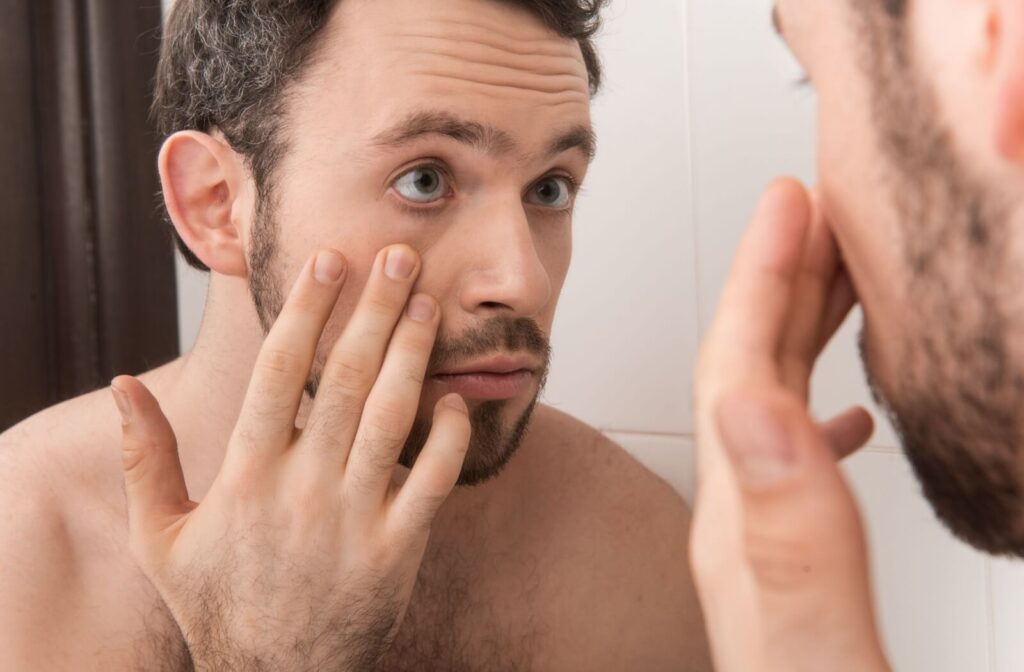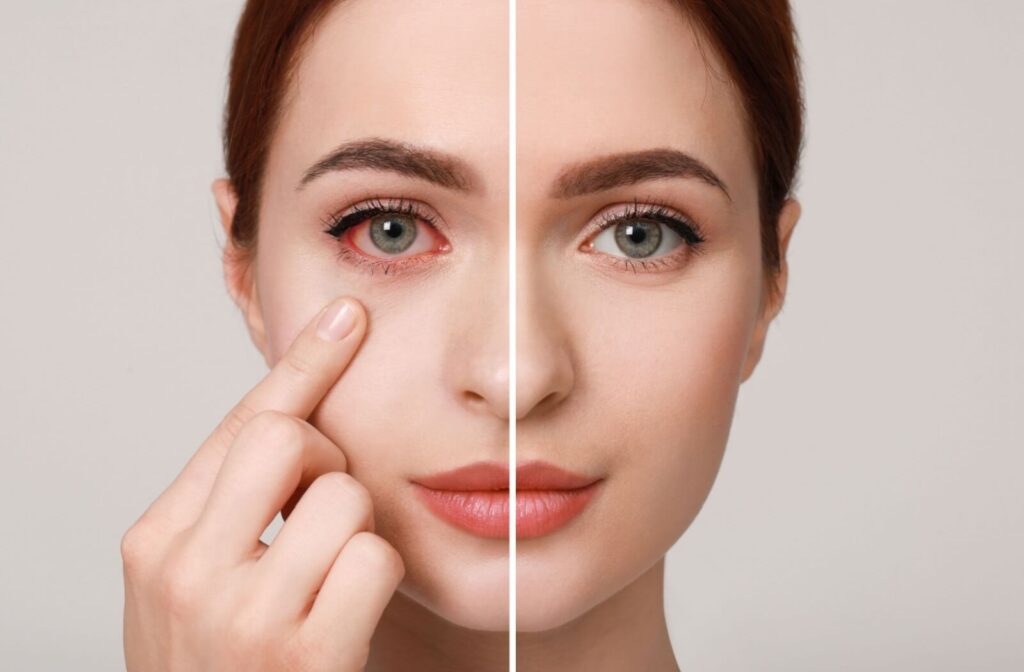Eye irritation can derail your day, whether you’re trying to focus on work, enjoy time outdoors, or relax at home—redness, discomfort, and blurry vision can make it tough to go about everyday life. When your eyes don’t feel quite right, it can be tricky to know what’s causing the problem. You may see some redness, but do you have pink eye or dry eye?
Pink eye typically involves sticky discharge and swelling, while dry eye presents with a gritty irritation and blurred vision without contagious symptoms. If you’re still unsure, your optometrist can examine your eyes and reveal the truth.
What Is Pink Eye?
Pink eye, also called conjunctivitis, is an inflammation of the conjunctiva, the thin, transparent membrane that covers the white of your eye. It can be triggered by bacteria, viruses, allergens, or irritants.
Some pink eye signs to watch for include:
- Redness: A pinkish or reddish hue across the white of your eye.
- Itchiness: A gritty, itchy feeling, as though something is in your eye.
- Discharge: Viral infections often cause watery discharge, while bacterial infections produce yellow or green pus.
- Swollen Eyelids: Your eyelids may puff up and feel tender.
- Crusty Lashes: Bacterial pink eye might result in your eyelashes sticking together due to discharge.
Is Pink Eye Contagious?
While there are different types of pink eye, bacterial and viral pink eye spread quite easily. They can quickly move through a school or workplace if people aren’t careful. Fortunately, stopping the spread simply takes some extra effort.
Follow basic hygiene practices like washing your hands, avoiding eye-touching, and limiting close contact with others while your symptoms persist to help reduce the risk of spreading it.
What Is Dry Eye?
Dry eye occurs when your eyes don’t produce sufficient amounts of or high-quality tears for eye lubrication. Your tears are an essential part of eye health. They’re more than just water, after all. They consist of 3 layers, which make up a tear film. Normally, this film keeps your eyes hydrated and comfortable. Any disruption can lead to dry eye as your tears may evaporate too quickly or simply not exist.
This may result from natural aging, prolonged screen time, certain medications, environmental elements like wind, or underlying health concerns.
Symptoms of dry eye include:
- Redness: Dry eye, like pink eye, causes irritation and redness, though it lacks the discharge associated with the former condition.
- Blurred Vision: Temporary blurriness that may clear up after you blink can occur.
- Light Sensitivity: Bright lights can cause noticeable discomfort.
- Stringy Mucus: Clear but sticky tear production may accompany dryness.
Is Dry Eye Contagious?
One of the biggest differences between pink eye and dry eye is that dry eye isn’t contagious. People may experience dry eye at the same time if it’s due to an environmental condition, but you can’t “catch” it from someone.
Although dry eye isn’t infectious, it shouldn’t be left untreated. Prolonged dry eye may lead to more significant issues, such as infection or surface damage to the eye.

Recognizing Dry Eye vs. Pink Eye
It’s clear both pink eye and dry eye share some symptoms, such as redness and irritation, but there are distinguishing features to focus on.
- Pink eye often includes watery or sticky discharge along with swelling and a more intense itchiness.
- Dry eye may cause your eyes to water as they seek relief from irritation, but you may have no discharge at all.
- Dry eye also isn’t contagious like viral and bacterial pink eye are.
If overlapping symptoms make it difficult to determine the cause, scheduling a comprehensive eye exam is always a safer option.
How to Treat Dry Eye & Pink Eye Conditions
While pink and dry eye can have some annoying symptoms, the good news is that effective treatments are available for both. Once you know what’s affecting you, your optometrist can recommend a solution.
Treatments for pink eye depend on the type. This can include:
- Bacterial pink eye: Prescribed antibiotic drops or ointments help clear bacterial infections.
- Viral pink eye: Viral pink eye usually resolves on its own within a week or so. Cold compresses and artificial tears can ease discomfort.
- Allergic pink eye: Antihistamine eye drops or oral medications reduce swelling and irritation caused by allergies.
Dry eye treatment is about managing symptoms and dealing with the root cause. Treatments can include:
- Artificial tears: Over-the-counter eye drops can provide short-term relief.
- Prescription medications: Anti-inflammatory drops may be recommended for long-term care.
- Lifestyle adjustments: Small changes like reducing screen time, adding a humidifier to dry indoor spaces, and staying hydrated can do wonders.
For more severe dry eye conditions, you should consult your eye doctor for tailored treatment.
Tips to Keep Your Eyes Healthy
Whether you’re dealing with irritation or looking to maintain healthy eyes over time, some everyday habits can make a big difference. Here are our tips:
- Follow the 20-20-20 rule: To reduce eye strain, every 20 minutes, refocus your sight on something 20 feet away for 20 seconds, especially during screen-heavy tasks.
- Wear sunglasses: Protect your eyes from harmful UV rays and look good doing it by wearing sunglasses outdoors.
- Choose nutrient-rich foods: Leafy greens, fatty fish, nuts, and citrus fruits provide nutrients (omega-3s, vitamins A, C, E) essential for eye health.
- Practice good eye hygiene: Wash your hands regularly, avoid touching your eyes unnecessarily, and never share personal items like towels or cosmetics to minimize the risk of infections.
By adding these simple practices into daily life, you can support better eye health for the long run.
See Ahead Clearly with iSight Optometry
Pink eye and dry eye might feel frustrating, but identifying the cause can radically improve your eye health. If symptoms persist or you’re unsure what’s causing your discomfort, don’t hesitate. A professional eye exam from iSight Optometry can offer precise answers and a clear action plan.
Your eyes deserve the best care. Book your appointment today and see what clarity feels like.





